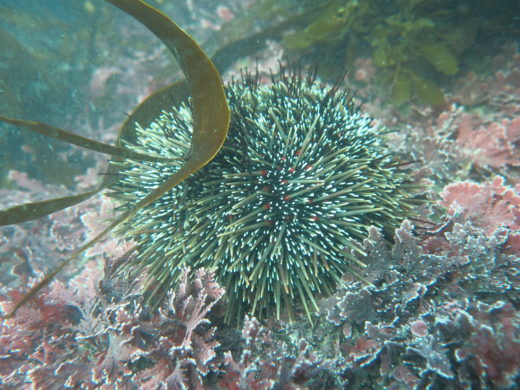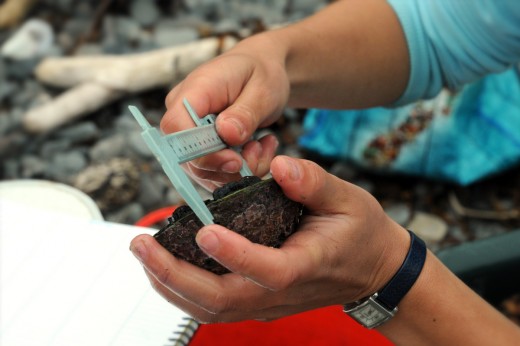What are Kai Species?
Kai means “Food.” Therefore, kai are plant and animal species that are locally important for food-gathering purposes. Such species include Kina, Paua, and Toheroa, among many others.
Kina
Genus: Evechinus | Species: chloroticus
Kina (also known as sea eggs) belong to a group of marine invertebrates known in scientific terms as Echinoids, which in turn are part of a larger group of animals called Echinoderms (echino = spiny and derms = skins). The New Zealand Kina is endemic to New Zealand and its offshore islands. It can grow to be as large as 190 mm in diameter, making it arguably the largest sea urchin species in the world.
Sea urchins are an important traditional food for Māori, who prized their internal organs and gonads. Sea urchins are often represented in the diets of indigenous peoples from other parts of the world as well. Recently, a global sea-urchin aquaculture industry has developed, mainly for the production of the valuable gonad.

Ecological Importance
Sea urchins are an important species ecologically. They are found in the intertidal zone, in most areas except estuaries and wave-exposed coasts. Sea urchins are mainly herbivorous, feeding on algae, but will also graze on encrusting invertebrates such as sponges and ascidians. Their grazing activity often controls the distribution of kelps and other encrusting species. In the most extreme cases, sea urchin populations can, through overgrazing, turn productive kelp-dominated marine communities into low productivity sea-urchin barrens devoid of kelp and its associated species.
Age and Longevity
Modelling of Kina growth suggests that they reach a size of 40-50 mm diameter in seven years, with larger individuals (>150 mm) probably aged 30-50 years. Food levels and water temperatures affect their growth rate, so there is variation in growth rates and sizes at different sites along the New Zealand coast.
Life Cycle
There are both male and female kina. They reach maturity at around 30 to 50 mm in diameter. They have an annual reproductive cycle, and spawn once a year, usually in the spring and summer months, depending on location. Sea urchins can be very productive, females can release over a million eggs in a single spawn! The eggs are small and are fertilized in the water by sperm from an adjacent male. The eggs hatch into free-swimming larvae that will develop into a larval form called a pluteus. The plutei spend about 4-6 weeks in the water column feeding on microscopic phytoplankton. At the completion of their planktonic larval development they are about 1-1.5 mm long, at which time they settle to the sea floor and metamorphose into tiny sea urchins about half a millimetre in diameter. To avoid being eaten, they quickly seek shelter under rocks and shells, or in crevices, and will remain in that cryptic nature until they are about 20-30 mm long.
Pāua
Abalone (Haliotis sp.)
Pāua are one of the most sought after (and fought over) kai moana species in Aotearoa. Customary and recreational harvests are in danger, due to the depressed stocks from a vigorous commercial harvesting industry.
55 different species are known worldwide. In New Zealand three species – the black foot, yellow foot, and virgin pāua – are known, which are most abundant on shallow reefs.

Reproduction
Pāua sexually mature at 3-5 years or at 60-90 mm in diameter. The size of a pāua depends on water temperature: the further south the bigger and therefore the greater size needed to reach maturity.
Unlike other molluscs, pāua are not hermaphrodites. Males and females can be distinguished before spawning; female gonads are dark green, while male gonads are cream-coloured. The molluscs spawn once a year, from late summer to October. Egg and sperm release through respiratory pores in the shell, triggered by water temperature dropping below 15°C and stormy conditions. The animals sense when their neighbours are spawning, prompting simultaneous spat release. This increases the number of fertilized eggs (each female releases seven million!), hence increasing the chances for survival of larvae. Although not well understood, it is known that larvae go through several developmental stages during a one-two week period. The settling of larvae depends on several factors, most important the temperature: the warmer the water, the faster larvae develop. It was found that pāua larvae settle within 5 km of their release area.
Reseeding
Settlement of pāua larvae and the following early development are encouraged by chemicals produced by different species of coralline algae. These coralline algae are well visible as pink patches on rocks and reefs in the intertidal and shallow sub-tidal areas, but can also be found at a depth of 270 metres. Tests in the laboratory have shown that even the species of coralline algae can matter for survival.
Western research on re-seeding pāua is still in its infancy in New Zealand; hence, collaborative work with communities interested in pāua re-seeding is of great importance for the sustainable management of the animal.
Toheroa
Paphies ventricosa
Toheroa are clam-like shellfish endemic to New Zealand. Considered one of the finest seafoods New Zealand has to offer, they are of limited supply and in need of careful management.
Habitat
Toheroa were once found in good numbers, but they are now only on a few beaches of both Te Ika A Maui (North Island) and Te Wai Pounamu (South Island). Toheroa are active burrowers, living 10-20 cm below the surface in the intertidal zone on beaches. (They have been found as deep as 300 metres below the sand!) When feeding, they extend their siphon past the surface sand to filter plankton out of the water.
Fisheries Management
Toheroa have long been important kai moana for Māori. Europeans quickly discovered toheroa as a delicacy, and opened two canneries in Northland in the early 1900’s, harvesting mainly from Muriwai and Ripiro Beaches. After reaching a high of 77 tonnes of canned product in 1940, toheroa stocks decreased to such low levels that commercial harvest was closed in 1969.
Recreational and customary harvest was first regulated in 1932, with a two-month closure, a harvest size of 3 inches (76,2 mm), and a bag limit of 50 shellfish per person per day. Size and numbers of toheroa were further regulated, resulting in the closure of all beaches. Local Māori currently manage all beaches inhabited by toheroa. Kaitiaki give toheroa harvest permits only for special occasions such as hui or tango.
Is toheroa recovery possible?
In Northland beaches, in particular at Ripiro Beach, kaitiaki have reported a slow but steady increase in toheroa numbers. This is thought to be the result of natural recruitment assisted by good management and protection.
On Oreti Beach in Southland, a recent report (Beentjes et al. 2006) indicates that the toheroa population could collapse due to significant erosion and sand loss. First reported in the 1980s the loss of sand has exposed the underlying gravel and cobble across half of the beach, most significantly in the high-intertidal zone critical to juvenile toheroa recruitment. The future for toheroa on Oreti Beach does not look good, if erosion continues.
Tātai kōrero ka ngaro, tātai kōrero ka rangona.
